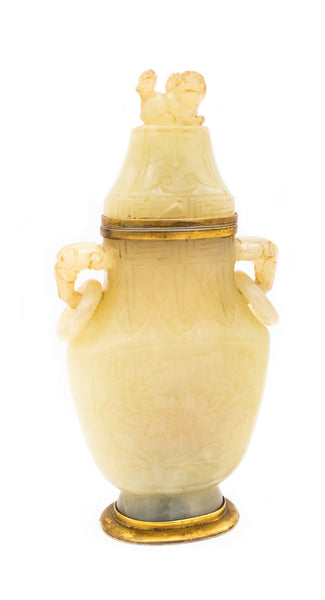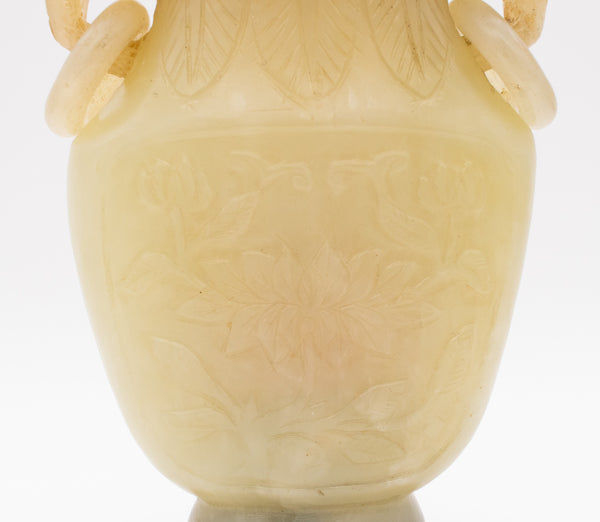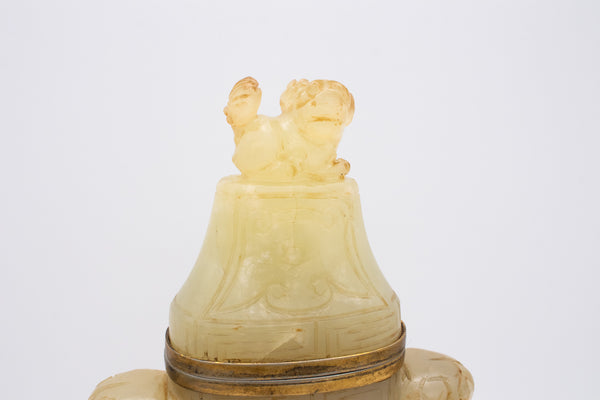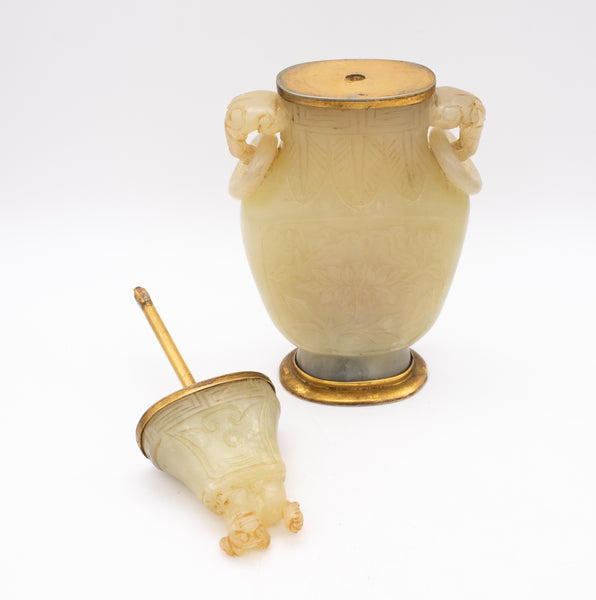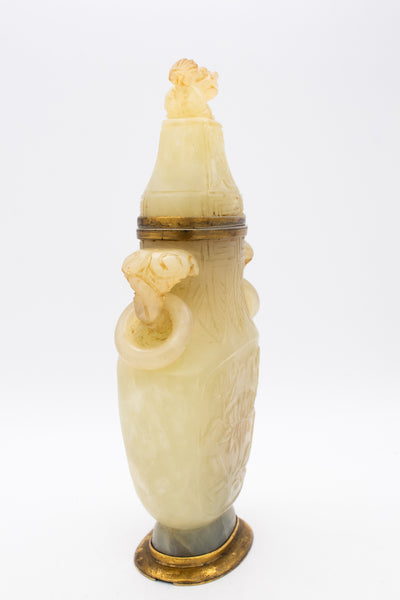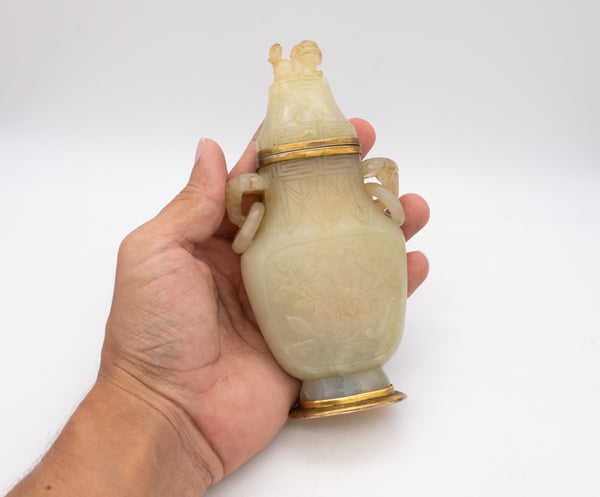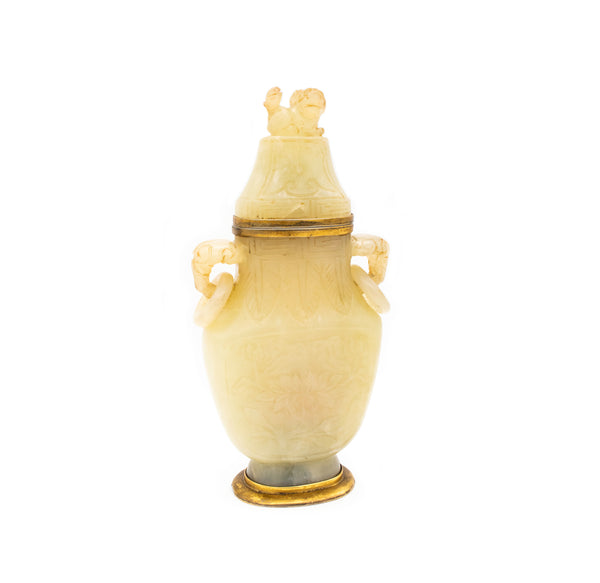+China 1880 Qing Dynasty Nephrite Jadeite Jade Urn Vase Por Perfumed Oil Scents
Perfume scent urn vase carved from nephrite jade Qing Dynasty (1644-1911).
An exceptional antique urn for perfumed scents from the 19th century. The carvings are from the Chinese, Qing dynasty (1644-1911) period, made circa 1800's. They are carved from solid pieces of natural brownish-green jadeite jade. The carving exhibit great skills and details, with organic motifs and a reclined Foo Dog on the top of the lid.
The Foo dog is resting in full, looking forward and reclining in a three-dimensional pose exhibiting great details, especially evident in the mane, teeth, claws and hairs.
The design is composed by two parts; the base that functions as a container for the scented oil, with two rounded movable elements on the sides and the lid with the gilded bronze pistil to apply the oiled perfume.
These pieces of jade were mounted in the late 19th century, in an ormolu base crafted from gilded sterling silver. the mountings were made by the J.J.F. & Co. This company was based in in the San Francisco area, United States. Surely this piece was been created for the us market.
Foo Dog or Pho Dog, is a traditional Chinese architectural ornament. Typically made of stone or jade, these decorations are also known as stone lions or "Shishi". Foo Dogs that are placed inside or outside a building are meant to protect your home or workplace from negative energy.
Since the introduction of this mythical lion symbolism from the Indian culture, specially through Buddhist symbolism, statues of guardian lions have traditionally stood in front of Chinese imperial palaces, imperial tombs, government offices, temples and the home of government officials and the wealthy, from the Han dynasty (206 bc-220 ad), and were believed to have powerful mythic protective benefits.
The Qing dynasty, officially the Great Qing, was the Manchu-led last dynasty in the imperial history of China. It was proclaimed in 1636 in Manchuria (modern-day Northeast China), in 1644 entered Beijing, extended its rule to cover all of China proper, and then extended the empire into Central Asia. The dynasty lasted until 1912. In orthodox Chinese historiography, the Qing dynasty was preceded by the Ming dynasty and succeeded by the Republic of China. The multiethnic Qing empire lasted for almost three centuries and assembled the territorial base for modern China. It was the largest Chinese dynasty and in 1790 the fourth largest empire in world history in terms of territorial size. With a population of 432 million in 1912, it was the world's most populous country at the time.
Qing Dynasty decorative arts, many craftsmen worked in the imperial court, producing artifacts for palace use: everything from items of jewelry art to beautiful Chinese lacquerware, including lacquered imperial thrones: see, for instance, the Qing Dynasty Imperial Throne (1775-80, Victoria and Albert Museum, London). The Imperial Household Department managed a number of crafts workshops both within the Forbidden City and outside it. Some of the skilled workers and master craftsmen were on permanent duty, like those in the imperial glass factory established in 1696 under the direction of the German Jesuit Kilian Stumpf (1655-1720). Other experts in gemstones carving, horn and jade sculpture and metallurgy were summoned to Beijing for a specific period of service.
The combined weight of this piece is 459.3 grams and have a measures of 6.75 by 3.18 by 1.5 inches, (17.15 x 8 x 3.81 cm).
The gilded ormolu mount, is stamped under the base with the maker's signature, " J.J.F. & Co. SF".
Literature: Jade, Ch'ing Dynasty Treasures, National Museum of History, exhibition at Taiwan, several authors, 1998 Pp-108-109. for similar examples.
Provenance: A private collection in New York city collected in the 1964; T.K. Asian antiquities gallery, Williamsburg Virginia; a private collection in Palm Beach FL; then purchased by James & Nancy Markell, Virginia 1976; then by descent to Lauren Markland, Fort Lauderdale, FL.; acquired in Palm Beach, FL. in March 7, 2021
Condition: The overall condition of this piece is excellent. Beside the little normal wear, there is no damage to any part. All pieces are secured in the settings. This piece has been carefully inspected to guarantee the condition and authenticity.
INVENTORY REF: D0000XTNN/.1111








